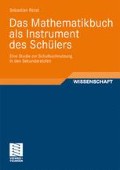Im vorangehenden Kapitel wurde gezeigt, dass sich etwa 90% der selbständigen Nutzungen des Mathematikbuches von Schülern auf die im Kapitel 1 entwickelten Instrumentationstypen zurückführen lassen. D. h., die in dieser Arbeit entwickelten Instrumentationstypen sind geeignet, einen Großteil der Verwendung des Mathematikbuches der Schüler dieser Studie im Zusammenhang mit den vier Tätigkeiten Bearbeiten von Aufgaben, Festigen, Aneignen von Wissen und interessemotiviertes Lernen zu beschreiben.
Access this chapter
Tax calculation will be finalised at checkout
Purchases are for personal use only
Preview
Unable to display preview. Download preview PDF.
Rights and permissions
Copyright information
© 2009 Vieweg+Teubner | GWV Fachverlage GmbH
About this chapter
Cite this chapter
Rezat, S. (2009). Nutzertypologie. In: Das Mathematikbuch als Instrument des Schülers. Vieweg+Teubner. https://doi.org/10.1007/978-3-8348-9628-5_7
Download citation
DOI: https://doi.org/10.1007/978-3-8348-9628-5_7
Publisher Name: Vieweg+Teubner
Print ISBN: 978-3-8348-0971-1
Online ISBN: 978-3-8348-9628-5
eBook Packages: Life Science and Basic Disciplines (German Language)

